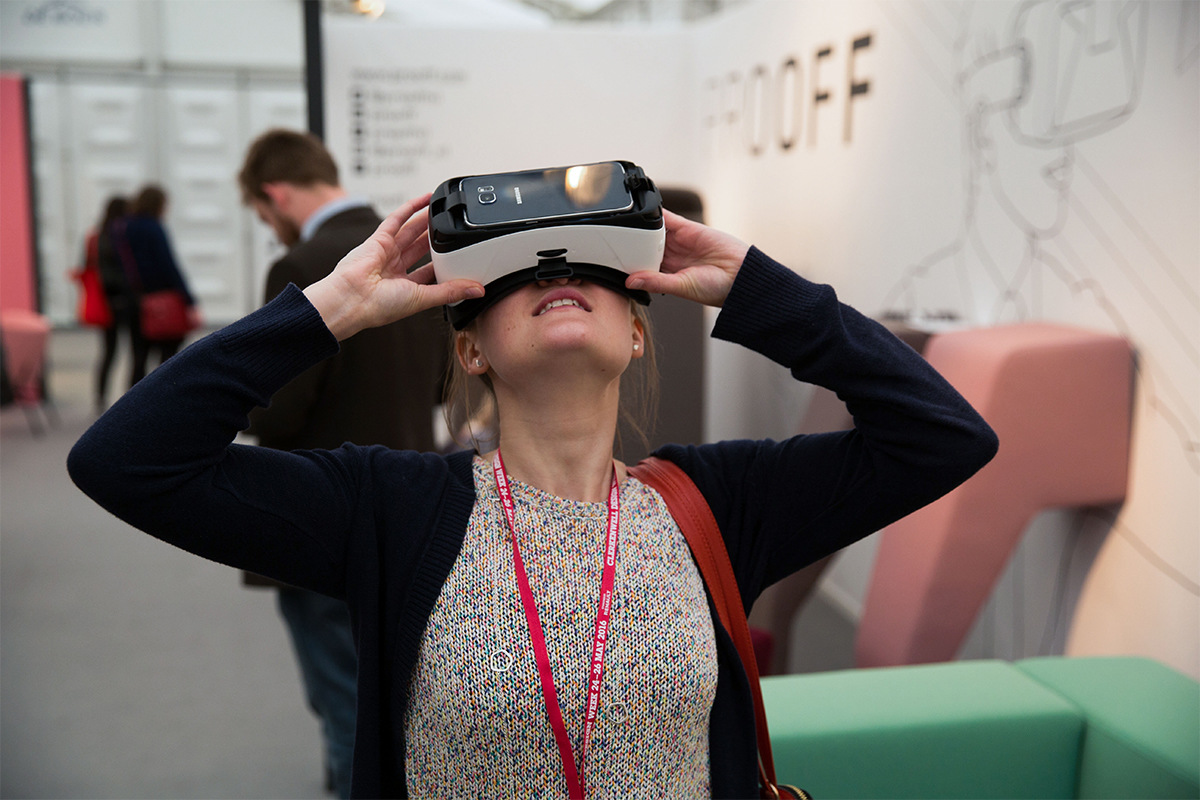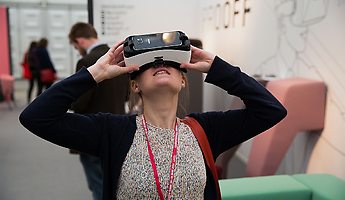

Experience Virtual Reality: Collaboration with PROOFF
UNStudio collaborated with the innovative Dutch furniture brand PROOFF to help them showcase a large range of office furniture at Clerkenwell Design Week 2016 in London. The design challenge for the furniture showcase was to create a way in which to exhibit a large amount of furniture pieces within a limited display space. As a solution, we explored the use of an immersive virtual environment to exhibit the furniture to visitors.
Through our experience designing the virtual environment for PROOFF, we discovered the many benefits virtual reality, or VR, could bring to the world of architecture. Following these initial explorations we decided to expand this technology further and look at VR not just as a tool, but as a step forward in how we interact with media, family and business.

At UNStudio we are often approached by clients and collaborators who come to us with an ambition – much as in the case of PROOFF – and we become the creative engine behind making these ambitions a reality. PROOFF originally approached us with the idea of displaying a large amount of furniture in a limited space, but their greater ambition is to redefine the future of workspaces while pushing the boundaries of furniture design. The concept of a proactive workspace became the key driver and catalyst to our experimentation with virtual reality.
As an architectural practice, while we often utilise high-resolution renderings, diagrams, drawings and/or sketches to represent our ideas and enable clients to connect with our solutions, we often desire to push these methods further. By constantly innovating our representational techniques, we endeavor to captivate the audience and storyline an idea, beyond traditional representation techniques. Because of our recent experience working with PROOFF, we have incorporated VR as an integral representational technique within UNStudio and will continue to explore new ways in which to use it.


The advantages of using virtual reality are fast becoming apparent within the architectural design process. Our initial uses of VR were limited to additional presentation techniques in which we could give our clients a more experiential look into the spatial qualities of designs. These were often times seen as additive or 'special features' and were offered to few clients due to the high cost of production. Through our collaboration with PROOFF, we were able to experience a range of applications for VR beyond merely an additional representational technique. Currently we have set up a dedicated VR room within UNStudio for the testing the potential for the use of VR within our practice.

VR is not the newest nor most innovative technology. Having been around for over 60 years since the first prototype [1], it has had considerable time to evolve. So why has it just recently come into the spotlight? Speculation as to whether VR would become mainstream was confirmed two years ago when Facebook purchased Oculus Rift, connecting the VR technology to 1.65 billion online users [2]. Recently, Sony made another stride towards mainstreaming VR when they announced their PlayStation VR headset, focused on gamers. This announcement revolutionised the market and created an affordable approach to VR, allowing users to utilise virtual reality without the need for expensive PC hardware. The PlayStation VR headset is already being used in 40 million households. VR is no longer just a niche product for a niche marketplace.

Now that VR is accessible, what do we do with it? Although VR has been around in theory since the 1950’s, it was not until the 1980’s – before even the advent of the internet – that VR was being researched for practical applications, such as medical uses. Today, possible applications for VR seem endless, with various industries such as the military, fashion and entertainment industries embracing VR for a multitude of reasons. Whether the technology is being used to remotely defuse a bomb, help NASA refit satellite units, or allow users to try on clothing in a virtual catalogue; VR has now entered mainstream consciousness. The cross-platform unifying factor of VR is its user-centric nature. VR allows users to feel more in control and creates a unique relationship between designers and end-users. This user experience is much like the IKEA effect, which describes the cognitive bias in which customers place a superfluous amount of value on products partially made by themselves – as appreciation and self-worth often outweigh the standard pre-made product. The most recent example of this relationship is the VR capable Rio Olympics, hosted by NBC. Together with Samsung, around 30 million viewers per night were able to access the Olympic Games in virtual reality, as long as the viewer owned a Samsung device. This type of usage sets the stage for marketing VR.

The Olympics are a staple in the sporting calendar, familiar to almost everyone worldwide. With VR, Samsung added a unique feature to a familiar experience, creating a more vivid memory for audiences utilising the new technology. VR is still relatively new to the average user. Marketing strategies are currently fixated on the newness of VR today, capitalising on users who are unfamiliar with the technology. However, this type of marketing can create a fleeting feeling and runs the risk that the technology may be considered merely a gimmick. We believe that over time, due to its accessibility and diverse applications, VR will prove to be a relevant tool for all, especially architects.
_____________________________________________
[1] "History Of Virtual Reality." Virtual Reality Society. 2016. Accessed August 9, 2016. http://www.vrs.org.uk/virtual-reality/history.html.
[2] Drummond, Katie, Ellis Hamburger, Thomas Houston, Ted Irvine, Uy Tieu, Rebecca Lai, Dylan Lanthrop, Christian Mazza, Casey Newton, Adi Robertson, Matthew Schnipper, Melissa Smith, Sam Thonis, and Michael Zelenko. "The Rise and Fall and Rise of Virtual Reality." The Verge. Accessed August 09, 2016. http://www.theverge.com/a/virtual-reality/intro.
UNStudio Team: Filippo Lodi, Megan Harford
